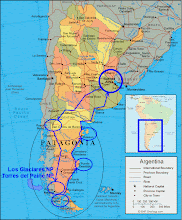
Ruta 40 heading south out of Bariloche is extremely scenic – the map should have those big dots beside the route. The road winds down glacial-formed green valleys surrounded by snow capped peaks, descending into a desert with low hills, and finally into darn good ranch land around Esquel. The rain we experienced in Bariloche had moved on and it was clear, cool, sunny day. Ruta 40 was paved the whole way, but the quality was a little rough starting an hour out of Esquel. Traffic was rare.
We stopped in El Bolson for a lunch at a nice restaurant that perhaps didn’t have everything listed on the menu: Bobbie ordered the Asado Tire (beef short ribs), and five minutes later a car pulled up front and a guy walked into the restaurant carrying a side of beef. A few minutes later we heard a meat saw do its thing, and a while later … viola, here came Bobbie’s meal. El Bolson is a scenic mountain town and it was a great break at the restaurant.


Now in Esquel, camping at a park just outside the city. Aftermath of earlier spillage disaster: inside of camper smells like sour milk.


No comments:
Post a Comment